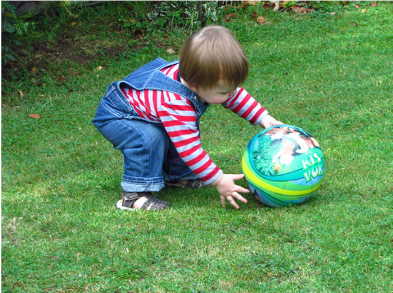Reaching for Mobility
Here’s an interesting and fun way to work on your functional mobility: just reach for something.
Step One: Get into any position that is a useful base for a wide variety of activities, such as standing, squatting, lunge, quadruped, or sitting in various positions on the floor.
Step Two: Pick an imaginary point to reach to with your hand, while maintaining one or more of your points of contact with the floor. Really reach, imagining that every millimeter counts in terms length and accuracy.
If you play with different variations on this basic formula, you will notice that you can challenge your range of motion at nearly every joint - ankles, hips, spine, ribs, shoulders, etc. Usually, you will be mobilizing many joint segments at once, in combinations that form functional patterns.
For example, get into a bear crawling position – feet flat on the floor in a squat position, hands palm down in front of the feet. Now slide the right hand as far as possible in front of you, while maintaining contact with your other three points of support. Try sliding your right hand to as many different points on the floor as possible, imagining you are painting a large area. You will challenge your functional mobility in the ankles, knees, hips, back, ribs and shoulders. Importantly, the different movements need to well coordinated, so there is a challenge to overall body coordination.
For an easier set of movements, try the same thing while sitting in a chair, reaching the right hand as far as possible down and up, front and back, left and right. Make sure to really reach to an imaginary target, as if each millimeter counts, while keeping at least some part of your pelvis on the chair, or your feet anchored to the floor. This will cause you to include distant parts of the body in the movement, so the ribs and pelvis work with the shoulder. Depending on where you reach, your pelvis and spine will flex, extend, side-bend, and rotate. Explore all the different possibilities and what they feel like, noting that many will feel like functional, real-world movements. Repeat the ones that feel good or useful, adding in subtle variations in foot position, posture, chair contact, etc.
Why does reaching to random points lead to movements that feel coordinated and familiar? Our primate ancestors lived in trees and spent a lot of time reaching for tree branches in random locations. Our bodies are well-organized to serve the needs of the hands to grasp distant things, and therefore reaching tends to get the body coordinated, especially into lengthened positions. When you reach, the body gets long in an intelligent way.
Here’s some reaching games in standing: see how far you can get from a wall and still make contact under different constraints: reaching low and high on the wall; with two feet facing the wall; with two feet angled left or right; allowing the back foot to come up for counterbalance. You will get into various hip hinge and lunge positions, some like a fencer, dancer or squash player.
Feet can be used for reaching, especially in positions where the hands hold onto something to provide balance, as in climbing, scrambling or crawling. You can play with reaching the foot in a standing position, and easily test all your potential ranges of motion in the hip. Try reaching a foot to touch various points on the wall, while facing toward, away, and sideways from the target. Use your hands as much as you want for balance.
You can lift a foot to clear hurdles, or place it onto a high box or table. If you reach the foot away from you along the floor, you will come into various lunge positions. This ends up being a strength workout for the supporting leg, showing that many kinds of mobility are really about stability and balance. You can get the same effect with the arms in a push-up position, sliding one hand forward along the floor while the other works to prevent you from falling.
The sit bones can “reach” as well. Part of their function is to make contact with surfaces that afford sitting, so reaching them toward a chair will create natural movements. This is why many people will squat with awkward form when told to squat, but squat quite naturally when told to sit.
Try lowering your butt to an adjustable stool. Easy? Move the seat lower, further away, closer, or to the left or right. Use different foot placements — close together and wide apart, heels up or down, and include asymmetrical positions. Try to touch one sit bone but not the other. You can use this simple game to explore the entire landscape of squatting possibilities. You can explore lunging by getting into a staggered stance and reaching your back knee to the ground, or your front hand to points in front of you.
The eyes can also “reach” to get a view of things. Turning to look up, down, left or right tend will invite cooperation from the whole trunk, and even the pelvis and legs. Get into a bear crawling position, keep the hands and feet glued to the flor, and then look up, down between the legs, left and right over the horizon. This is a challenge to full body integrated mobility.
I play with reaching style movements every day, usually as a warm up for a squash game or workout. Over time, I figured out which movements felt most beneficial, and then sped them up to be more dynamic and challenging.
Try playing around with reaching and see what emerges.
The post above was an adapted except from my book Playing With Movement: How to Explore the Many Dimension of Physical Health and Performance







